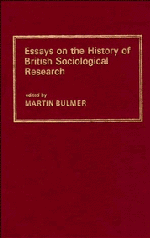Book contents
- Frontmatter
- Contents
- Preface
- Contributors
- Introduction
- History
- 2 Social monitors: population censuses as social surveys
- 3 The emergence of the sociological survey, 1887–1939
- 4 Durkheim, Booth and Yule: the non-diffusion of an intellectual innovation
- 5 The Government Social Survey
- 6 Methodological research on sample surveys: A review of developments in Britain
- 7 Mass-Observation 1937–1949
- 8 The Institute of Community Studies
- 9 Provincials and professionals: the British post-war sociologists
- 10 On the eve: a prospect in retrospect
- Use
- Index
8 - The Institute of Community Studies
Published online by Cambridge University Press: 12 November 2009
- Frontmatter
- Contents
- Preface
- Contributors
- Introduction
- History
- 2 Social monitors: population censuses as social surveys
- 3 The emergence of the sociological survey, 1887–1939
- 4 Durkheim, Booth and Yule: the non-diffusion of an intellectual innovation
- 5 The Government Social Survey
- 6 Methodological research on sample surveys: A review of developments in Britain
- 7 Mass-Observation 1937–1949
- 8 The Institute of Community Studies
- 9 Provincials and professionals: the British post-war sociologists
- 10 On the eve: a prospect in retrospect
- Use
- Index
Summary
The Institute of Community Studies was formally established in 1953, with the creation of a charitable trust bearing that name. It started operations at the beginning of 1954, when Peter Townsend and I joined Michael Young in one room in Oxford House, a settlement in Bethnal Green. We moved within six months to occupy part of the Queen Anne house in Victoria Park Square which we were eventually to buy as a permanent base. This chapter concentrates on the first ten or so years.
Young had raised the initial money, covering his salary, mine and office costs, from the Elmgrant Trust, the Dartington Hall charity. A further grant was obtained from the Nuffield Foundation, for a study by Townsend of old people. Peter Marris completed the quartet of founder members when he joined after about a year.
Why Bethnal Green? It had been selected by Young for the research he had begun in 1951, before the Institute was launched, into the effects of rehousing on working-class family and community life. The district had to be one, in London, which had a predominantly working-class population and from which people had been rehoused. East London was right on both counts, and Bethnal Green (then a separate borough) was chosen partly because Ruth Glass (Glass and Frenkel, 1946) and James Robb (1954) had done research in the area and partly because it was relatively compact (57,000 people in 1953).
- Type
- Chapter
- Information
- Essays on the History of British Sociological Research , pp. 137 - 150Publisher: Cambridge University PressPrint publication year: 1985
- 6
- Cited by



